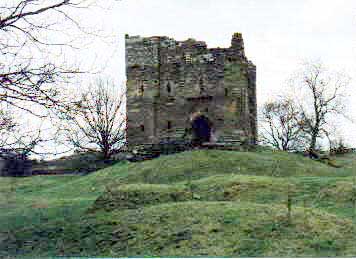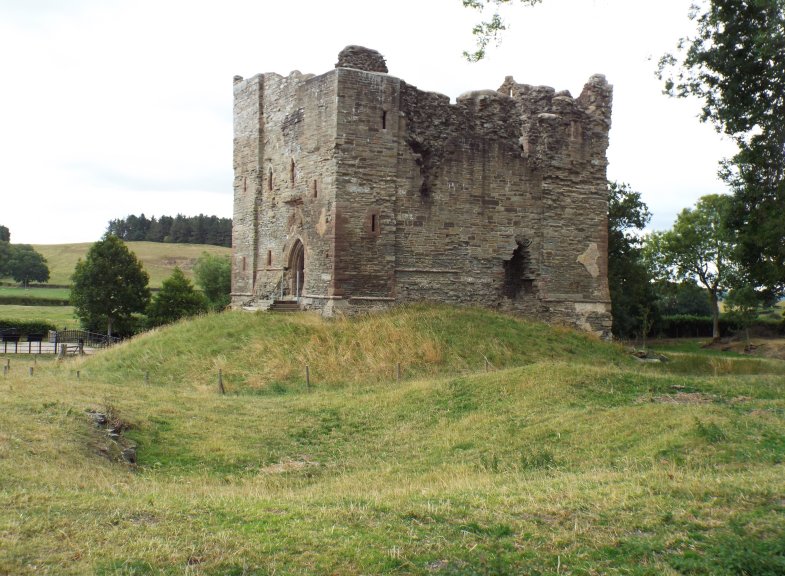Hopton
It is uncertain when Hopton
castle was built, but it is likely that the family of Hopton were
responsible for this act during the Anarchy of King Stephen's
reign. By the reign of King Henry II the Hoptons, Peter
(d.1155/60) and then Walter Hopton (d.1200+) were the major honourial
baron of Clun lordship. As such the Hoptons rose in the service
of such families as the Says, Fitz Alans and Mortimers. During
the barons' wars of the 1260s Walter Hopton (d.1305) became sheriff of
Shropshire and Staffordshire and later an important royal justice who
was much complained of by English and Welsh litigants alike. He
also gave his name to the Hopton Commission, King Edward I's method of
pacifying all the outstanding disputes of the Welsh Wars in 1278.
As such Walter became the king's chief justice and was personally
responsible for the creation of the account of these legal proceedings
that became known as the Hopton Roll. It has been suggested that
he used his new found importance and wealth to refurbish his ancestral
castle as a powerful motte and bailey fortress. He also made
enemies, competing for precedence with men of a higher social status,
such as Reginald Grey of Wilton and Ruthin and John Lestrange of
Knockin and Middle. Against that Walter always seems to have had
the backing of the powerful Roger Mortimer of Wigmore (d.1282), even
though he held most of his lands in and around Hopton by service to
Fitz Alans of Clun, who had inherited Hopton itself with all the lands
Picot Say was holding there as demesne in 1086. Indeed Hopton
owed knight service at both Clun and Wigmore castles for 40 days in
time of war for various lands he held. He also held lands of the
Mortimers of Richards Castle. Oddly as well as being the vassal
of the Fitz Alans he was also their lord for the manor of
Alcastor. An unusual occurrence. Walter also became sheriff
of Shropshire and was ordered to give up the position on 28 May
1270. Presumably he was misnamed Robert when appointed sheriff
Hopton on 29 September 1267 as his name appears on the pipe roll for
1268 for that year and the last.
Walter seems to have had a powerful personality as his royal wages were
always paid promptly and when they were not paid in full Hopton was
forceful in demanding his arrears be paid. His career began in
1255, 4 years after his father's death, with him taking our 3 writs
before 1260. Presumably he was suing for his rights. This
suggests he found the law amenable to his ambitions. However, he
failed to live up to his promises, being chased by litigants and
involved in violent actions against the burgesses of Shrewsbury when
they crossed his path. He also cheated on his marriage
contract. In 1281 Walter had married Matilda Pantulf, one of the
heiresses to Wem castle and had then systematically stripped the
lordship of its wealth to the detriment of his step-son, William Butler
(d.1283), and later after William's death he took £15 pa out of
Wem lordship ‘for his services'. Such services seem to have
included suing the royal custodian of Wem for carrying out his legal
duties and stealing 4 suits of steel armour, 4 steel
gorgets, a suit of mail from Wem castle and all the ornaments from the castle
chapel. On the complaint of the friends of William Butler's children, as well as Hopton's repeated defaults in not appearing in court, it was
ordered that Walter was to be distrained for these crimes. However,
Walter simply claimed that he had been distrained illegally and
demanded a trial by jury. Sadly the outcome of this is not
recorded. In the meantime Walter cut down the trees of Wem's
forest and generally sold Butler's goods. In reply Walter claimed
that he held a life interest in Wem and therefore could do as he
pleased. According to Walter's marriage contract this was not
true and Walter only held an interest in the barony while his wife
lived. She had died in 1281.
On 7 May 1290 Walter fell foul of King Edward I and was imprisoned in the Tower of London and fined 500m
(£333 6s 8d) for corruption. During this time his wife,
Matilda Pantulf, died in June 1290, but Walter continued to hold Wem
through ‘the courtesy of England'. Despite these problems
he was soon back in royal favour and was twice elected to assess royal
taxes and became knight of the shire in 1304. At some point after
1290, Walter went on to marry Ela Herdeburgh and had by her a much
wanted son, Walter, who was born before 1303. The last Walter
Hopton died during the Wars of the Roses and the castle passed by
marriage to the Corbets of Moreton Corbet castle.

Description
Hopton castle appears a typical motte and bailey structure lying in
lowland, with its outer defences being waterworks in the muddy
ground. The castle seems to have been founded as a motte and
bailey with the motte lying to the south-east of the bailey over its
south-east corner. Quite possibly the ‘motte' is a
secondary feature to the bailey. Beyond the motte and bailey
ditch to the south-east is a probably late medieval fish stew, mostly
within an outer enclosure which defends the east, west and south sides
of the castle in an U shape, with the new car park possibly overlying
the outer defences. The longest side is about 425' long and has a
ditch about 40 wide and 6' deep. The scarp to the east appears to
mark the edge of the flood plane of the diminutive Llan brook.
Between the car park and the fish pond are 2 odd features. To the
north is a cut running down to the brook which may have been used to
drain the castle moat, while just south of this is an odd circular
depression about 30' in diameter. This is certainly man made, but
whether it is the foundations of a round tower or a waterwork is
uncertain.
The motte and bailey was once surrounded by a wet ditch about 30'
across and 10' deep, which is now mostly silted up. The bailey is
sub rectangular with uneven rounded corners, about 140' north to south
and 120' east to west. There are numerous indications of
buildings including a rectangular block running east to west about a
third of the way down the bailey from the north and an oblong or D
shaped tower at the south-west corner of the ward, roughly 20'
square. There are also traces of the curtain of the enceinte.
The keep stands on the rather pathetic motte, standing only 6' high and
having a base diameter of 110'. The surrounding ditch is somewhat
smaller than that around the bailey. The keep at 45'x40' was
similar in size to the keep at Criccieth (43'x32') and Dolwyddelan II
(44'x31') in Gwynedd, the large tower keep (45'x33') in the bailey at
Richards Castle in England and Adare (43'x35') in Limerick,
Ireland. Despite this, the castle which appears nearest to Hopton in style could well be Pendragon castle.
The tower was entered from the north, probably from a
bridge running from the north-western corner of the bailey where there
are still jumbled earthworks. This led into an entranceway which
had a spiral stair to the west. Within the entrance was a
rectangular room with mural chambers in 2 pilaster buttresses to the
angles of the east wall. The south-west angle had a larger
buttress which contained the garderobe chutes, while the west wall had
a single window which has been largely smashed out. The vice led
up to the second floor which served as a solar to the small hall
below. This had mural chambers in 3 of the turrets, the fourth
being taken by the vice. A small vice off the south-west turret
apparently led to the battlements.
The decorations on the keep, corbelled out chamber above the entrance,
decorative string course at ground level and fine plinth, all point to
a thirteenth or fourteenth century date, but the bailey defences could
well be as old as the Hopton barony which seems to have existed during
the reign of King Stephen (1135-54).
The remains of Hopton castle, both the keep/tower house and the earthwork remains are fully explored as well as two nearby castle sites at the Rabbit Berries and Warfield Bank.
Hopton Castle, 1066 to 1282 (ISBN 1-899376-01-1) [1994] can be ordered for £4.95 through the PayPal basket below.
